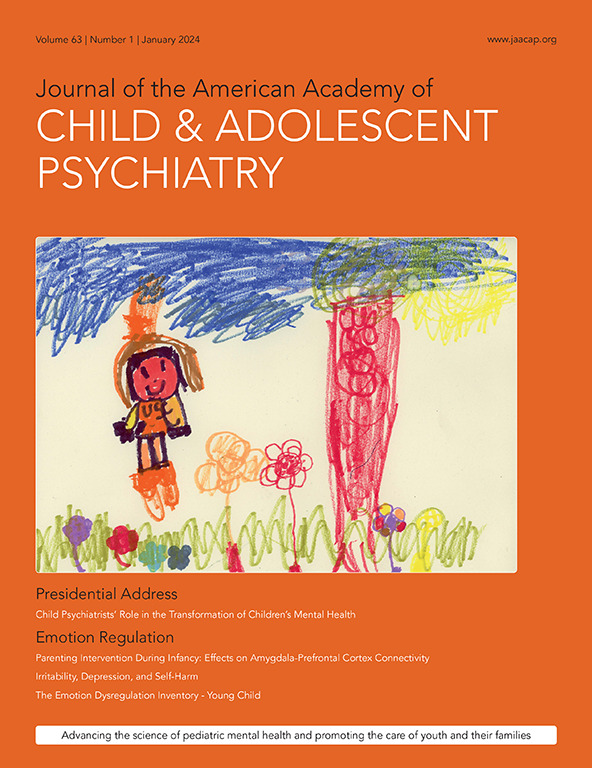认知定义的注意缺陷/多动障碍亚型具有不同的神经和临床特征,并且对阿托莫西汀的反应不同。
IF 9.2
1区 医学
Q1 PEDIATRICS
Journal of the American Academy of Child and Adolescent Psychiatry
Pub Date : 2025-07-15
DOI:10.1016/j.jaac.2025.07.007
引用次数: 0
摘要
目的:adhd在临床和病因学上在多个组织层面具有异质性。我们试图通过基于ADHD的共同特征(包括抑制控制、持续注意力和工作记忆)识别认知亚型来分析ADHD的异质性。我们试图在其他有意义的组织水平上使用结构来验证亚型:定量脑电图(qEEG)、临床症状和对托莫西汀和哌甲酯治疗的反应。方法对一个临床样本(n=112)的认知测量进行分层聚类分析。在第二组临床样本(n =336)中进行了重复性测试。使用静息状态qEEG和心率评估聚类亚型的神经有效性,并使用ADHD和焦虑症状评分评估聚类亚型的临床适用性。此外,在阿托莫西汀或哌醋甲酯治疗六周后,研究小组评估了治疗反应的差异。结果识别并复制了两个由特定认知概况定义的集群。抑制控制亚型在qEEG δ (β = -0.47, p = 4.89*10°-9)、θ (β = -0.39, p = 7.84*10°-6)和β (β = -0.36, p = 4.21*10°-7)波段的活性较高,静息心率较高。在临床上,该亚型患者的焦虑程度(M = 7.6, SD = 6.0)也明显高于持续注意亚型患者(M = 4.7, SD = 4.3, p = 0.02),且对托莫西汀的疗效明显优于持续注意亚型患者(β = 8.4, p = 0.008, Cohen’SD = 0.71)。结论:认知表现对于识别具有独特神经基础的ADHD亚型似乎是有效的,并且可能特别受益于非兴奋剂,如阿托西汀。本文章由计算机程序翻译,如有差异,请以英文原文为准。
Attention-Deficit/Hyperactivity Disorder Subtypes Defined by Cognition Have a Distinct Neural and Clinical Profile and Differ in Response to Atomoxetine.
OBJECTIVE
ADHD is clinically and etiologically heterogeneous across multiple levels of organization. We sought to parse the heterogeneity of ADHD by identifying cognitive subtypes based on common features of ADHD, including inhibitory control, sustained attention, and working memory. We sought to validate the subtypes using constructs at other meaningful levels of organization: quantitative electroencephalogram (qEEG), clinical symptoms, and response to treatment with atomoxetine and methylphenidate.
METHOD
Hierarchical cluster analysis of cognitive measures defined clusters in one clinical sample (n=112). Replication was tested in a second, held-out clinical sample (n =336). Cluster subtypes were assessed for neural validation using resting-state qEEG and heart rate, and for clinical applicability using ADHD and anxiety symptom ratings. Further, clusters were assessed for differential treatment response after six weeks of atomoxetine or methylphenidate.
RESULTS
Two clusters defined by specific cognitive profiles were identified and replicated. The inhibitory control subtype was distinguished by more activity in qEEG Delta (β = -0.47, p = 4.89*10ˆ-9), Theta (β = -0.39, p = 7.84*10ˆ-6), and Beta (β = -0.36, p = 4.21*10ˆ-7) bands, and higher resting heart rate. Clinically, this subtype also had more severe anxiety (M = 7.6, SD = 6.0) than the sustained attention subtype (M = 4.7, SD = 4.3, p = 0.02), and had a markedly better response to atomoxetine (β = 8.4, p = 0.008, Cohen's d = 0.71).
CONCLUSION
Cognitive performance appears effective for identifying ADHD subtypes that have a distinct neural basis and that may particularly benefit from non-stimulants such as atomoxetine.
求助全文
通过发布文献求助,成功后即可免费获取论文全文。
去求助
来源期刊
CiteScore
21.00
自引率
1.50%
发文量
1383
审稿时长
53 days
期刊介绍:
The Journal of the American Academy of Child & Adolescent Psychiatry (JAACAP) is dedicated to advancing the field of child and adolescent psychiatry through the publication of original research and papers of theoretical, scientific, and clinical significance. Our primary focus is on the mental health of children, adolescents, and families.
We welcome unpublished manuscripts that explore various perspectives, ranging from genetic, epidemiological, neurobiological, and psychopathological research, to cognitive, behavioral, psychodynamic, and other psychotherapeutic investigations. We also encourage submissions that delve into parent-child, interpersonal, and family research, as well as clinical and empirical studies conducted in inpatient, outpatient, consultation-liaison, and school-based settings.
In addition to publishing research, we aim to promote the well-being of children and families by featuring scholarly papers on topics such as health policy, legislation, advocacy, culture, society, and service provision in relation to mental health.
At JAACAP, we strive to foster collaboration and dialogue among researchers, clinicians, and policy-makers in order to enhance our understanding and approach to child and adolescent mental health.

 求助内容:
求助内容: 应助结果提醒方式:
应助结果提醒方式:


